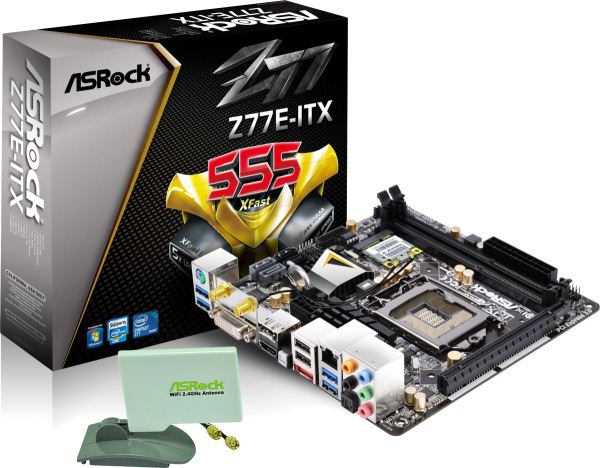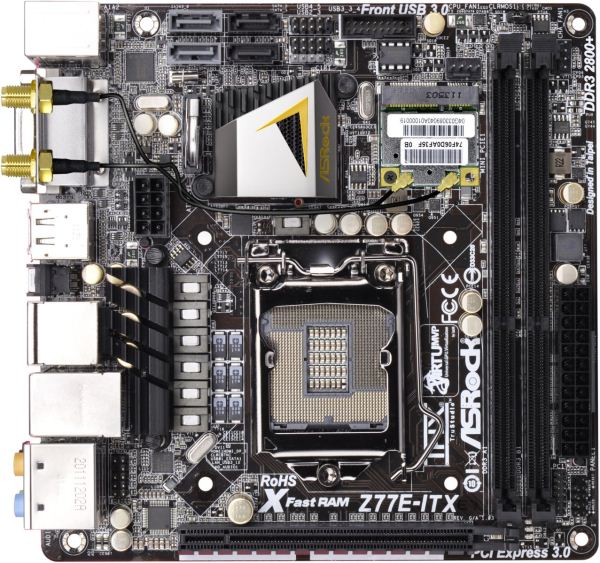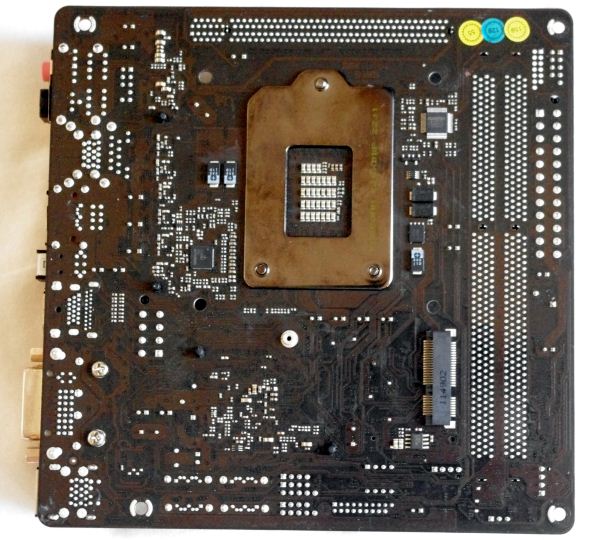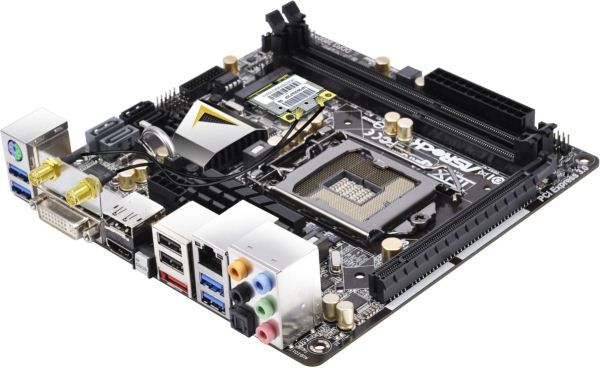Z77 mITX Round-Up: Five of the Best – MSI, Zotac, ASRock, EVGA and ASUS
by Ian Cutress on December 31, 2012 7:00 AM EST- Posted in
- Motherboards
- MSI
- ASRock
- EVGA
- ZOTAC
- Asus
- Ivy Bridge
- Z77
- mITX
ASRock Z77E-ITX Overview
Before I even started testing the ASRock Z77E-ITX, I could see murmurings online in the various forums I use about it. For the interests of remaining unbiased, I steered away from those threads. The ideal scientific test of a motherboard would be a double-blind study – the board can be reviewed and tested, but any tell-tale signs or markings on the product pointing it towards a single manufacturer would be removed. Unfortunately testing is not always scientifically perfect, but we can at least be as thorough as possible in our analysis.
The ASRock Z77E-ITX presents the user with a novel way (in the consumer desktop space) of solving the issue of limited PCB area – moving components to the rear of the motherboard. We are not talking just resistors – ASRock have moved the mSATA port to the rear. This frees up the main topside of the PCB for a mini-PCIe with 802.11b/g/n WiFi, a proper location for the 8-pin CPU connector, an easier-to-remove BIOS chip, and a lot more components on the board. This thing looks filled.
Other functionality on board gives us a Broadcom BCM57781 network controller, the Realtek ALC898 audio codec and an ASMedia ASM1042 USB 3.0 controller. The two 4-pin fan headers are found on the top left of the board, although on closer inspection the power delivery chokes may give cause for concern. Their open top design suggests iron core chokes, similar to those used on low end motherboards, rather than the iron powder or alloyed chokes on their higher end models. However after talking to ASRock, these are actually iron ferrite chokes, used for small space / high power systems such as servers. This should lead to reasonable temperatures under severe stress, and typically server parts are rated to be more than adequate for that severe stress.
The BIOS of the Z77E-ITX uses the older UEFI design of white on blue, compared to the new starry background design and distribution of options. We still get access to the System Browser, which cunningly gives a peak of the back of the board due to that mSATA placement, the Online Management Guard and Internet Flash for BIOS updates through the internet. We also get the dehumidifier functionality for equilibrating high-moisture situations inside and outside the case to reduce condensation in those climates. Software is standard ASRock, with ASRock always wanting to promote their XFast 555 system of RAM, LAN and USB. The latter may not be of use under Windows 8, and the chances of RAM cache use in a mITX are slim, but access over the network priority is a useful tool to have. While the fan controls are not the best, they did work in my testing over the range of tools available.
The ASRock Z77E-ITX sits at the low end in terms of cost in our review at $150 – significantly cheaper than the EVGA at least. With a weird orthogonal antenna in the box, DVI-I to D-Sub adaptor too, and performance which is not too far off from what we expect from the platform, the ASRock does pull at the wallet waiting for a build.
Visual Inspection
Like most motherboard manufacturers at the minute, ASRock has their color scheme – in this case we the aim is for a gold and black combination, however the way ASRock designs its motherboards means that we also get a lot of white. This is due to the placement of the components via SMT – in order to guide the automated process which places the components on board, each component has a small white box around where it should be. All these boxes printed on the board means that technically ASRock has less space to place components, and it alters the aesthetic perception of the product in the end.
Starting with the socket placement, ASRock like others in this review have placed the socket underneath the chipset and up against the memory/PCIe slots. This restricts coolers to the x-y dimensions specified by Intel, unless one invests in low profile memory. As always with mITX gaming builds, I would recommend an all-in-one liquid cooler. The socket area has access to both of the CPU fan headers on board – the 4-pin CPU header is above the mini-PCIe slot, and the 4-pin chassis header is to the top right of the memory slots. Arguably placing the two fan headers close together may not be the best idea in terms of placement.
The rear of the board is where we find this mSATA port. Now that mSATA drives are below the $1/GB, they become a wonderfully viable option in the motherboard space for those wanting to save space or who are not going RAID-0. (Even though there could be scope for two mSATA on motherboards in the future.)
North of the socket we have the chipset heatsink, which ASRock have decided not to connect to the power delivery heatsink. As mentioned previously, the style of the chokes used in the power delivery seems to suggest that simple iron cores are being used. Simple iron cores are the current low end and cheaper implementation of chokes, leading to lower efficiency and high heat loss, especially when compared to iron powder chokes, alloy chokes, super ferrite chokes, or PowIRstages. Talking with ASRock points these chokes towards the iron ferrite versions used in servers, meaning that they should still be able to provide enough power during overclocks, even if the mITX motherboard is not the ideal place to start overclocking a motherboard to the fullest – especially given that Ivy Bridge processors can get very hot in correlation to their voltage.
Around the chipset heatsink we get the SATA ports – two SATA 6 Gbps and two SATA 3 Gbps. The motherboard battery is stood straight out of the motherboard in order to save space, and below this we have the 8-pin ATX power connector. This is still in the middle of the board but perhaps not as bad as other implementations which require the power cables to stretch over everything in order to get to it. To the right of the chipset we have a USB 3.0 header, as well as the mini-PCIe port with a 2.4 GHz 802.11b/g/n WiFi module already strapped to it.

The rear IO panel looks more like a standard ATX build rather than a mITX oriented one. From left to right we have a combination PS/2, two USB 3.0 from an ASMedia ASM1042, the two antenna ports, a DVI-I, HDMI, DisplayPort, a Clear_CMOS button, two USB 2.0, an eSATA, a Broadcom BCM57781 network port, two USB 3.0 from the chipset and audio jacks containing an optical SPDIF output.
Board Features
| ASRock Z77E-ITX | |
| Price | Link |
| Size | Mini ITX |
| CPU Interface | LGA-1155 |
| Chipset | Intel Z77 |
| Memory Slots |
Two DDR3 DIMM slots supporting up to 16 GB Up to Dual Channel, 1066-2800 MHz |
| Video Outputs |
HDMI DisplayPort DVI-I |
| Onboard LAN |
Broadcom BCM57781 802.11 b/g/n WiFi |
| Onboard Audio | Realtek ALC898 |
| Expansion Slots |
1 x PCIe 3.0 x16 1 x mSATA 1 x mPCIe |
| Onboard SATA/RAID |
2 x SATA 6 Gbps (Chipset) RAID 0, 1, 5, 10 2 x SATA 3 Gbps (Chipset) RAID 0, 1, 5, 10 1 x mSATA 3 Gbps (Chipset) 1 x eSATA 3 Gbps (Chipset) |
| USB |
4 x USB 3.0 (Chipset) [2 back panel, 2 onboard] 2 x USB 3.0 (ASMedia ASM1042) [2 back panel] 6 x USB 2.0 (Chipset) [2 back panel, 4 onboard] |
| Onboard |
2 x SATA 6 Gbps 2 x SATA 3 Gbps 1 x mPCIe (Used by WiFi b/g/n) 1 x mSATA 3 Gbps (on rear) 2 x USB 2.0 Headers 1 x USB 3.0 Header 2 x Fan Headers 1 x Front Panel Audio |
| Power Connectors |
1 x 24-pin ATX Power Connector 1 x 8-pin CPU Power Connector |
| Fan Headers |
1 x CPU (4-pin) 1 x CHA (4-pin) |
| IO Panel |
1 x Combination PS/2 Port 2 x Antenna 1 x DVI-I 1 x HDMI 1 x DisplayPort 1 x Clear_CMOS Button 2 x USB 2.0 1 x eSATA 3 Gbps 1 x Broadcom NIC 4 x USB 3.0 1 x Optical SPDIF Output Audio Jacks |
| Warranty Period | 3 Years |
| Product Page | Link |
Compared to the other boards in the review, the use of a Realtek ALC898 is good to see, whereas the Broadcom BCM57781 NIC is an unknown factor. I like the mSATA and mPCIe combination, and putting the mSATA on the rear of the board is a great idea – it means that in the future other items such as the battery or SATA ports may migrate there as well. Price wise the ASRock board comes in as one of the cheapest in this review, and given the inclusions in the package (shown later), it makes it a nice product all around from a technical standpoint. The only additions I would have liked to have seen onboard is a two-digit debug, and if possible, power/reset buttons.














54 Comments
View All Comments
IanCutress - Monday, December 31, 2012 - link
Gigabyte wanted their H77 reviewed instead, which we reviewed recently: http://www.anandtech.com/show/6427Athelstan - Monday, December 31, 2012 - link
Thanks for the review. I'm curious why you mention the audio chip on all of these board. For the intended purpose, wouldn't the audio be over HDMI, making the onboard audio unused in most cases? Even then, all of the boards have optical out, making the audio chip to have very little to do other than to pass along the bitstream from the media thought the optical connection.IanCutress - Monday, December 31, 2012 - link
The audio chip also controls the front panel audio, and even if the audio was going through the HDMI, external speakers for a HTPC may be used via the audio jacks. In my personal usage scenario, my video out is via DVI-D to a 2560x1440 Korean panel via a dGPU, meaning all my audio still goes through the normal audio jacks. The other reason is that if I did not mention it, someone in the comments would ask why wasn't the audio chip mentioned. There is a price difference between the ALC889, ALC892 and ALC898, though manufacturers obviously get these on bulk deals (or at a discount when bought with the Realtek 8111E/F) and I am not privy to that information.Ian
Taft12 - Monday, December 31, 2012 - link
Speaking of audio, could you let us know the differences between those 3 Realtek audio chipsets? Is there any sound quality difference, or is it only features?mczak - Monday, December 31, 2012 - link
The 892 has somewhat crappy ADC/DACs quality-wise (that said most likely signal routing etc. on the board will have a much bigger effect on sound quality than the quality of the DACs, so using a higher quality chip can still easily result in worse quality than using a cheap chip with more care taken). The 889 and 898 seem quite similar there on paper.I think just about the only thing you'd really miss is the dolby digital live / dts connect features (encode multichannel audio to digital if you're using the digital outputs). But these are pure software features, so you can get them with the 892 as well - I believe though the board manufacturers are more likely to license them with the more expensive chips (I don't know if you could "upgrade" your chip with unofficial means there...). Realtek actually seems to list different ordering numbers depending on these features - interestingly there while all 3 of these chips are listed as a version without any of DDL/DTS Connect, only the 889 has a version with both of them, while the 892 only has a version with DTS Connect, and the 898 only has the version without them - the datasheet still lists those features as optional however.so maybe they just stopped using different ordering numbers (the 889 clearly is the oldest of the 3).
Athelstan - Monday, December 31, 2012 - link
*grins* Good point. If you don't mention it someone else would be asking for it.Stacey Melissa - Monday, December 31, 2012 - link
I'm running the ASUS board, and installed the AI Suite for a different ASUS Z77 board in order to get access to Fan Expert 2, which has far better fan control than v.1. Wish I could remember which Z77 board it was, but all I did was check the download pages for various Z77 boards to find one that included AI Suite with Fan Expert 2.IanCutress - Monday, December 31, 2012 - link
MSI include a program as part of the package to update the software, making sure you have the latest available. ASUS and Gigabyte need to do this ASAP, so people can take advantage of things like Fan Expert 2 without having to visit the website. System integrators often just install the drivers and software on the CD when selling a system, and then the user never updates it unless told to by either (a) friends or (b) the software itself.Ian
mfenn - Monday, December 31, 2012 - link
Am I the only one who is getting tired of the liberal copy-pasting of content between motherboard (and SSD) reviews on this site? I don't need to waste my time reading about the MSI design competition in every single review.I understand the need to provide background information to readers who may not peruse every single review, but that's why Tim invented the hyperlink. Link to the old review or to a purpose-built "company profile" page.
Sabresiberian - Tuesday, January 1, 2013 - link
Adding info some may be familiar with is preferable to leaving it out. If you don't want to read it, then I suggest you just skim or skip it entirely. :)